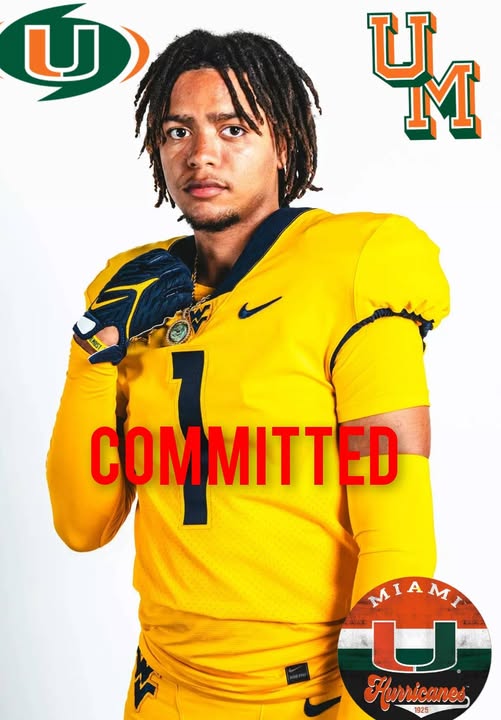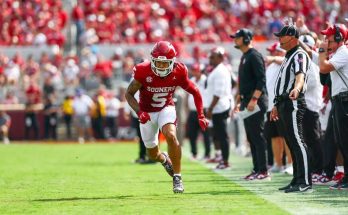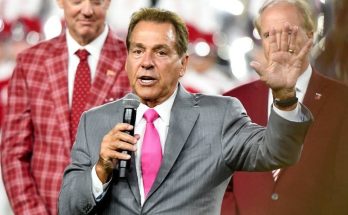In a move that has sent shockwaves through the college football landscape, a five-star quarterback has made headlines by decommitting from West Virginia and flipping his commitment to the Miami Hurricanes. This shocking change of direction, coming on the heels of one of the most closely watched recruitment processes in recent memory, has left fans and analysts alike scrambling to comprehend the ramifications of his decision.
The quarterback in question had been a key piece of West Virginia’s recruiting strategy, with Mountaineers fans already picturing him as the future face of their program. However, just days before National Signing Day, the unthinkable happened. The star recruit, who had long been considered one of the top players in the country, announced his decommitment from West Virginia in a statement that stunned many in the college football community. What followed was even more surprising: he declared that he would be committing to the Miami Hurricanes over some of the most prestigious and successful programs in college football history, including Penn State and Alabama.
At the heart of this seismic shift is a young player whose talent has been impossible to ignore throughout his high school career. A quarterback with all the tools to be a future star at the collegiate level, he has impressed scouts with his incredible arm strength, poise under pressure, and ability to read defenses with the precision of a seasoned veteran. His decision to switch his commitment, however, reflects more than just a change in programs—it speaks to the broader trends and challenges in modern college football recruiting.
For months, the quarterback had been publicly committed to West Virginia, a program with a proud history and a coaching staff that had invested significant time and energy into his recruitment. His decision to choose the Mountaineers initially came as a surprise to many, given his status as one of the nation’s most sought-after prospects. Yet, in a landscape where recruiting battles are constantly evolving, the quarterback’s commitment to West Virginia was seen as a testament to the school’s ability to secure high-level talent.
However, as the recruiting cycle wore on, it became increasingly clear that the player’s recruitment was far from over. While West Virginia remained a strong contender, other programs—most notably Penn State and Alabama—began to ramp up their efforts, hoping to sway him into reconsidering his options. The stakes were high for these programs, with both schools offering a chance to play in some of the most competitive conferences in the country. The allure of playing in the Big Ten or the SEC was certainly tempting, but the quarterback appeared to remain solid in his commitment to the Mountaineers, despite the increased attention from other elite programs.
But just when it seemed that the decision had been made, the unexpected occurred. In a move that caught the entire college football world off guard, the quarterback made the announcement that he was decommitting from West Virginia. The news was met with immediate speculation, as fans and analysts alike attempted to decipher the reasoning behind such a dramatic turn of events.
It didn’t take long for the next twist in the story to emerge. Miami, which had long been seen as a dark horse in the race for the quarterback’s services, surged to the forefront of the conversation. The Hurricanes, led by head coach Mario Cristobal, had been quietly making their case to the quarterback for months, emphasizing their vision for his role in the offense and the opportunity to be part of a program on the rise. Miami had been quietly building momentum under Cristobal’s leadership, and the addition of a player of this caliber would be a game-changer for their recruiting efforts.
The quarterback’s decision to flip to Miami wasn’t just a win for the Hurricanes—it was also a significant blow to both Penn State and Alabama. The Nittany Lions, fresh off a successful season and with a strong history of developing quarterbacks, were seen as one of the favorites in the race. Penn State had made a compelling case to the player, with the promise of a big-stage program in the Big Ten that could offer exposure and a chance to compete for conference titles. Similarly, Alabama, with its national pedigree and unmatched success under head coach Nick Saban, had been a perennial contender in the recruitment of elite quarterbacks. The Crimson Tide, who had been making strides in their recruiting efforts, saw the quarterback as a potential game-changer for their program, one who could lead them into a new era of dominance.
For both programs, losing out on the five-star quarterback is a setback, but the bigger picture shows how recruiting battles are shifting. The quarterback’s decision to flip to Miami reflects a growing trend in college football: the rise of programs that are building something special under new leadership. In Miami’s case, the combination of Cristobal’s experience, the allure of playing in the ACC, and the chance to be the centerpiece of a program with championship aspirations likely played a pivotal role in the quarterback’s decision.
As for West Virginia, the loss is a major blow, especially considering the amount of effort the program had invested in securing his commitment. West Virginia had hoped to build its offense around the quarterback, and his decision to decommit leaves the Mountaineers in a difficult position as they scramble to adjust their recruiting strategy. With so many other elite programs in pursuit of top-tier quarterbacks, it will be a challenge for the Mountaineers to quickly fill the void left by the quarterback’s departure.
But perhaps the most significant aspect of this recruitment saga is the power dynamic it reflects within the world of college football. In years past, schools like Alabama and Penn State were seen as automatic frontrunners in recruiting battles for elite talent. Yet in the modern recruiting landscape, it’s not just about history and tradition; it’s also about the vision a coach can offer, the style of play, and the opportunity for a player to be part of something special. Programs like Miami, which had been somewhat overlooked in recent years, are now finding themselves back in the mix for top-tier recruits, proving that even traditional powerhouses have to contend with the growing competition from schools that are on the rise.
For the quarterback, the move to Miami represents an exciting new chapter in his football journey. He now joins a Hurricanes team that is eager to return to prominence and build a program capable of competing for national championships. The decision to play for Miami, under the tutelage of Cristobal, offers him the chance to thrive in a dynamic offense and help lead the team back to its former glory.
As for the college football world at large, this decommitment and flip to Miami is another reminder of how unpredictable and thrilling the recruiting process can be. No matter how much effort goes into building relationships, no matter how many visits and pitches a program makes, nothing is ever certain until the ink dries on the letter of intent. This recruiting saga has shaken the foundations of college football, and it will be fascinating to see how the story unfolds as this talented quarterback begins his journey with the Miami Hurricanes.



